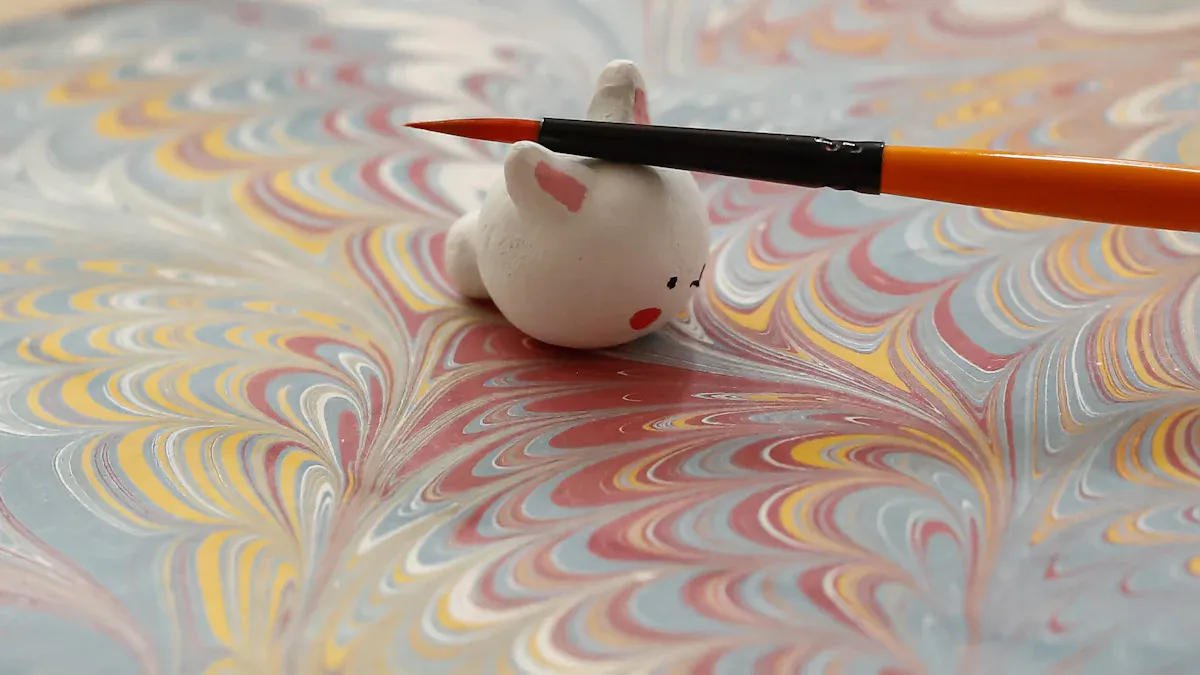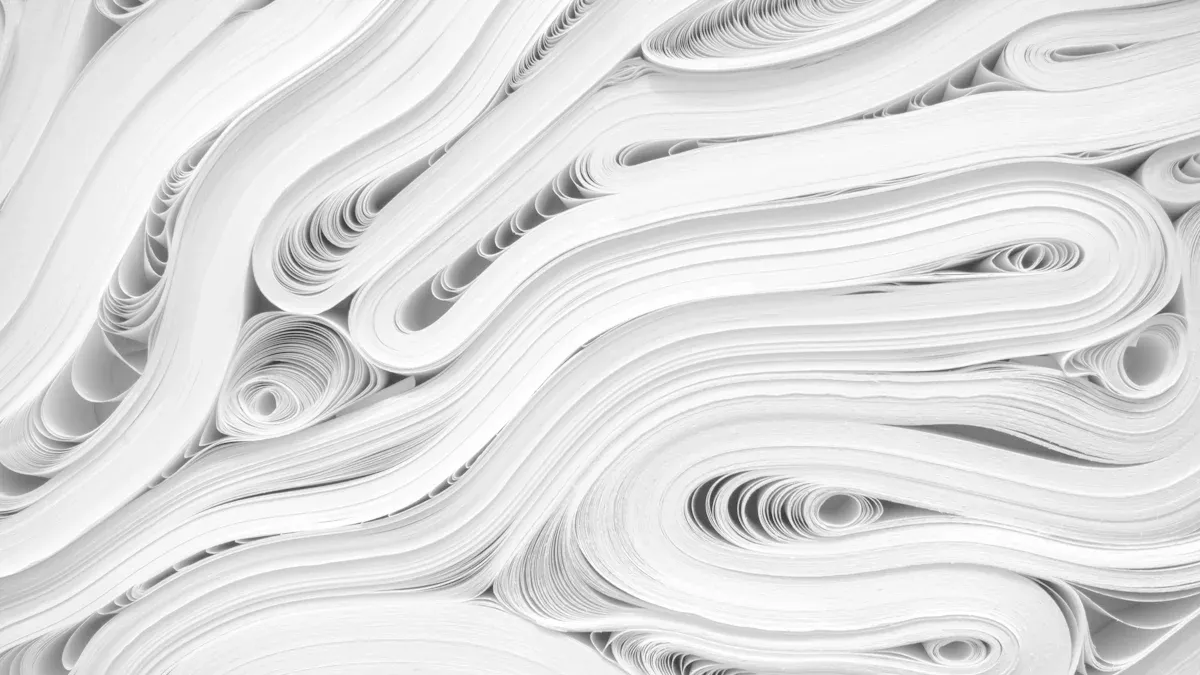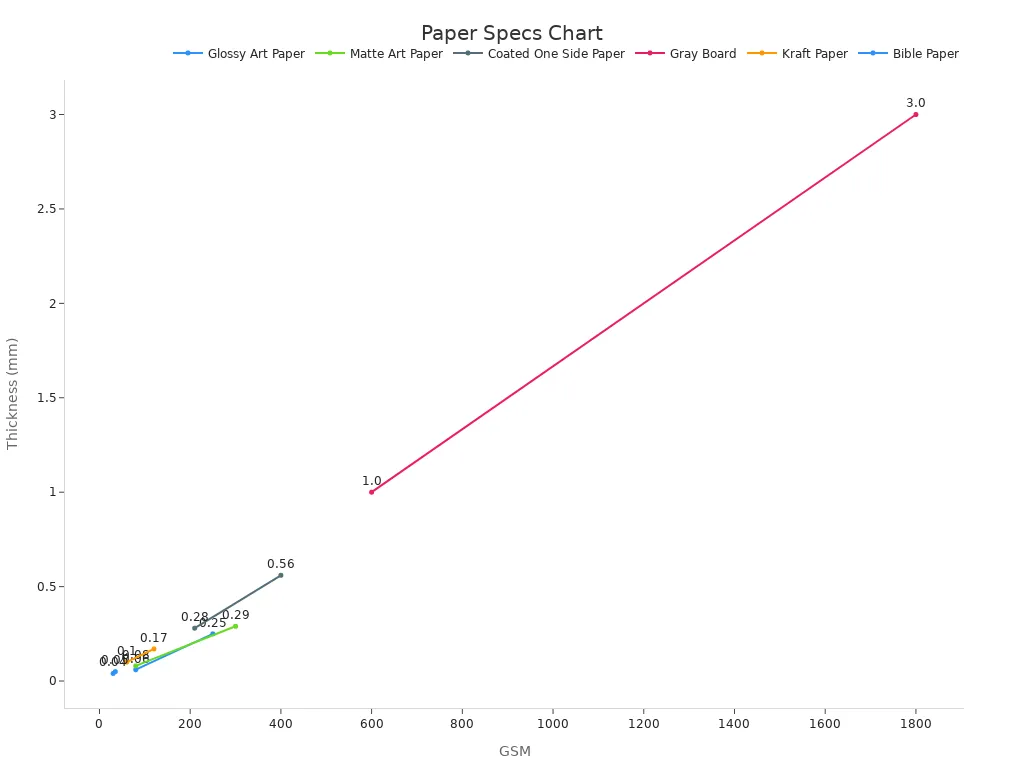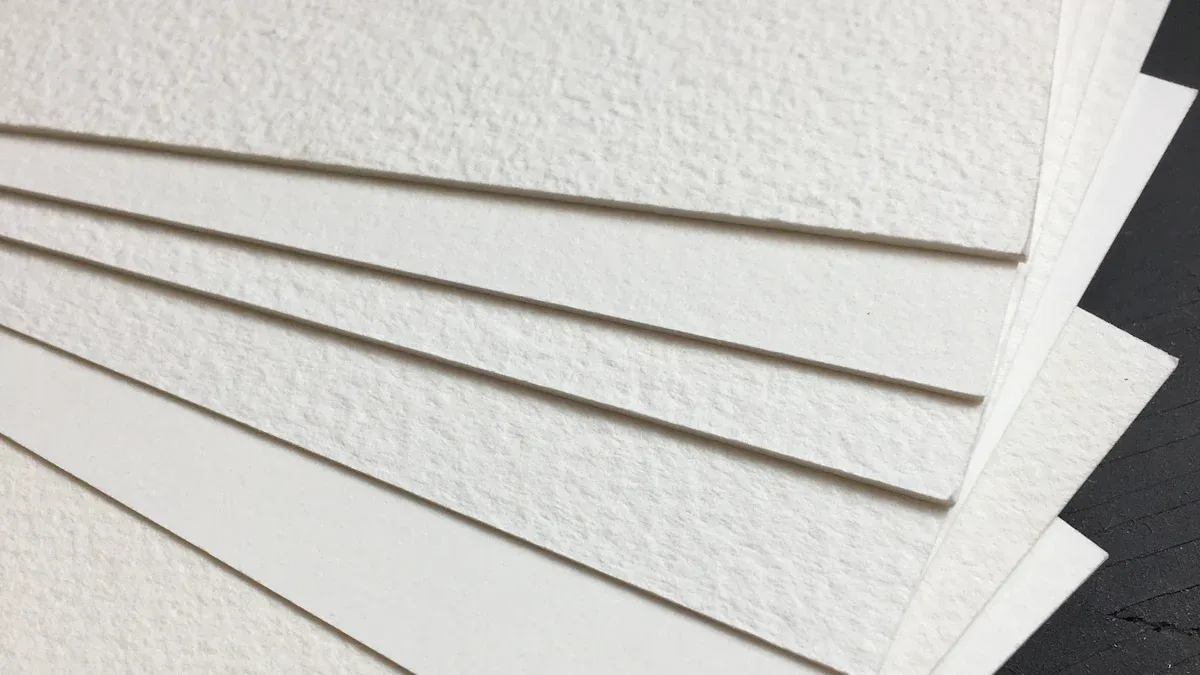
Double Side Coating Art Paper sets a high standard for creative projects. Market data shows that coated fine papers, such as C2s Art Paper and Art Paper Board, deliver vibrant colors and crisp images. Artists and printers value options like Art Board With Customized Size for its smooth finish and reliable double-sided performance.
Why Double Side Coating Matters
Definition of Double Side Coating
Double side coating refers to the process of applying a smooth, protective layer to both sides of a sheet of art paper. This technique enhances the paper’s surface, making it ideal for high-quality printing and creative projects. The technical specifications of double side coating highlight its advanced construction and versatility:
| Specification | Details |
|---|---|
| Coating | Triple coating on printing surface; single coating on back side |
| Composition | 100% virgin wood pulp; bleached chemical pulp; BCTMP filler |
| Printability | High print smoothness; good flatness; high whiteness (~89%); high gloss; vibrant colors |
| Processability | Compatible with post-printing processes, including aqueous coating |
| Storability | Good light resistance; long-term preservation in non-direct sunlight |
| Printing Compatibility | Suitable for high-speed sheet offset printing |
| Sizes and Grammage | Sheets and rolls; grammage from 100 to 250 gsm; customizable sizes |
| Thickness Range | 80 to 400 gsm |
This structure ensures Double Side Coating Art Paper meets the needs of demanding print jobs and creative applications.
Benefits for Artists and Printers
Double side coating offers clear advantages for both artists and printers. Coated Two Sides (C2S) paper provides a uniform surface on both sides, which allows for vibrant colors and sharp details throughout a project. Artists can create double-sided prints, portfolios, or marketing materials without sacrificing quality. Printers benefit from reliable performance, as the coating supports high-speed printing and consistent results. Double Side Coating Art Paper stands out for its ability to deliver professional-grade results, making it a preferred choice for brochures, postcards, and fine art reproductions.
Key Features of Double Side Coating Art Paper

Surface Finish Options: Matte, Gloss, Satin
Artists and printers can choose from several surface finishes when selecting Double Side Coating Art Paper. Each finish offers unique qualities that influence the final appearance of artwork or printed materials. Glossy finishes provide a shiny, reflective surface that enhances color vibrancy and contrast. Matte finishes deliver a flat, non-reflective look, which reduces glare and resists fingerprints. Satin finishes offer a balance between gloss and matte, featuring a slight texture that maintains vibrant color reproduction while minimizing glare.
| Finish Type | Coating Layers | Surface Quality | Color & Contrast | Glare & Fingerprints | Ideal Use Cases |
|---|---|---|---|---|---|
| Gloss | Multiple | Shiny, reflective | Vibrant colors, high contrast | Prone to glare and fingerprints | Colorful, vibrant artwork; photos without glass framing |
| Matte | Single | Flat, dull | Less vibrant, reduced contrast | Minimizes glare, resists fingerprints | Artwork emphasizing texture or text; framed under glass |
| Satin | Intermediate | Slight texture | Vibrant color reproduction | Reduced glare and fingerprints | Gallery-quality photos, portfolios, photo albums |
Glossy paper uses a glazing process to create a brilliant shine, making it ideal for images that require vivid detail. Matte paper, with its rougher texture, works well for pieces that highlight detail over shine. Satin finish paper provides a middle ground, suitable for portfolios and gallery-quality prints.
Weight and Thickness
Weight and thickness play a crucial role in the performance and feel of Double Side Coating Art Paper. Heavier and thicker papers provide a more substantial feel and greater durability. Lighter papers work well for projects that require flexibility or easy handling. The relationship between weight (measured in GSM or pounds) and thickness (measured in microns or millimeters) helps determine the best paper for each application.
| Paper Type | Pounds (lb) | GSM Range | Thickness (microns) | Typical Use Examples |
|---|---|---|---|---|
| Standard Sticky Note | 20# bond | 75-80 | 100-125 | Notes, memos |
| Premium Printer Paper | 24# bond | 90 | 125-150 | Printing, office use |
| Booklet Pages | 80# or 100# text | 118-148 | 120-180 | Booklets, flyers |
| Brochure | 80# or 100# cover | 216-270 | 200-250 | Brochures, covers |
| Business Card | 130# cover | 352-400 | 400 | Business cards |
The following chart shows how GSM relates to thickness for different paper types:

For example, glossy art paper ranges from 80 GSM at 0.06 mm thickness to 350 GSM at 0.36 mm. Matte art paper ranges from 80 GSM at 0.08 mm to 300 GSM at 0.29 mm. These measurements help users select the right paper for posters, brochures, or business cards.
Ink and Media Compatibility
Double Side Coating Art Paper supports a wide range of inks and printing technologies. The special coating on both sides allows for sharp image reproduction and prevents ink from bleeding through the sheet. This compatibility ensures that both dye-based and pigment-based inks adhere well, resulting in crisp lines and vibrant colors. Printers can use this paper for offset printing, digital printing, and even specialty processes like aqueous coating. Artists benefit from the flexibility to use markers, pens, or mixed media without worrying about smudging or feathering.
Tip: Always check the printer and ink specifications to match them with the paper type for the best results.
Archival Quality and Longevity
Archival quality matters for artists and professionals who want their work to last. Double Side Coating Art Paper often uses 100% virgin wood pulp and advanced chemical treatments to resist yellowing and fading. The coating protects against light exposure, ensuring that prints remain vibrant over time. Proper storage away from direct sunlight further extends the lifespan of finished pieces. Many premium papers meet industry standards for archival quality, making them suitable for portfolios, exhibitions, and long-term display.
Real-World Performance of Double Side Coating Art Paper

Print Clarity and Detail
Artists and printers expect sharp lines and crisp images from high-quality art paper. Double side coating technology creates a smooth, even surface on both sides of the sheet. This uniformity allows ink to sit on top of the paper, rather than soaking in. As a result, printed images show fine details, clear text, and precise edges. Photographers and graphic designers often choose this type of paper for portfolios and presentations because it captures every nuance of their work. Even small fonts and intricate patterns remain legible and sharp.
Note: Consistent coating on both sides ensures that double-sided prints look professional, with no loss of quality from front to back.
Color Vibrancy and Accuracy
Color reproduction stands as a key strength of Double Side Coating Art Paper. The special coating locks in pigments and dyes, preventing them from spreading or fading. This process produces vibrant, true-to-life colors that match the original artwork or digital file. Designers rely on this paper for projects where color accuracy matters, such as marketing materials, art prints, and photo books. The coating also reduces the risk of color shifts, so both sides of the paper display consistent hues and tones.
- Vivid reds, blues, and greens appear bold and saturated.
- Subtle gradients and skin tones remain smooth and natural.
- Both sides of the sheet maintain the same level of brightness and clarity.
This level of performance helps artists and printers achieve gallery-quality results, even with complex images or demanding color requirements.
Handling and Durability
Durability plays a crucial role in the real-world use of art paper. Double Side Coating Art Paper undergoes rigorous testing to ensure it withstands frequent handling, folding, and long-term storage. Manufacturers use a range of assessments to verify toughness and longevity. The following table summarizes key durability tests and their findings:
| Test Type | Description | Standards/Methods Used | Key Findings |
|---|---|---|---|
| Accelerated Aging Tests | Dry heat (105°C), hygrothermal (80°C, 65% RH), UV-light aging for 21 days on simulated samples | ISO 5630-1:1991, GB/T 22894-2008 | Simulated samples aged to mimic embrittlement conditions |
| Folding Endurance | Measured on 150×15 mm specimens using YT-CTM tester | ISO 5626:1993 | Folding endurance increased by 53.8% to 154.07% after cotton mesh reinforcement post-aging |
| Tensile Strength | Measured on 270×15 mm specimens with QT-1136PC universal testing machine | ISO 1924-2:1994 | Tensile strength improved after reinforcement; Japanese washi better for tensile strength than cotton mesh |
| Microscopic Morphology (SEM) | SEM imaging before and after aging to observe fiber integrity and surface cracks | SU3500 tungsten filament SEM at 5 kV | Cotton mesh samples showed no cracks after aging; Japanese washi samples showed surface cracks after aging |
| Chromatic Aberration | Color change measured by X-RiteVS-450 spectrophotometer using CIE Lab* system | CIE Lab* system | Used to assess visual changes post-treatment and aging |
| Durability Retention Rates | Retention of folding endurance and tensile strength after aging | Calculated from mechanical test results | Reinforced samples retained 78-93% folding endurance and showed 2-3 times higher durability than unreinforced |
These tests confirm that reinforced samples retain most of their strength and flexibility, even after exposure to heat, humidity, and light. The paper resists cracking and tearing, making it suitable for projects that require frequent handling, such as portfolios, brochures, and art books.
Tip: Proper storage away from direct sunlight and moisture further extends the life of printed materials.
Top Double Side Coating Art Paper Brands in 2025
Uinkit Double-Sided Matte Paper: Strengths and Best Uses
Uinkit Double-Sided Matte Paper stands out for its smooth, non-reflective finish. Artists and designers choose this paper for projects that require sharp text and detailed images. The matte surface resists fingerprints and glare, making it ideal for portfolios, greeting cards, and brochures. Uinkit’s paper supports both dye and pigment inks, which helps users achieve consistent results on both sides. Many professionals use this paper for double-sided printing because it prevents ink from bleeding through.
Amazon Basics Glossy Photo Paper: Strengths and Best Uses
Amazon Basics Glossy Photo Paper offers a shiny, vibrant surface that enhances color and contrast. Photographers often select this paper for photo albums, marketing materials, and presentations. The glossy finish brings out the richness in images, making colors appear more vivid. This paper dries quickly and resists smudging, which helps users handle prints right after printing. Amazon Basics provides a cost-effective option for high-quality photo projects.
Red River Paper Polar Line: Strengths and Best Uses
Red River Paper Polar Line delivers outstanding color performance and deep blacks. The M3 profile for this paper shows a larger color gamut, reaching over 972,000, which means it can display a wider range of colors than many competitors. The M3 profile also achieves lower black point values, resulting in richer blacks and better shadow detail. Polarization in the M3 measurement reduces surface reflections, improving print quality in dark tones and grayscale images. Artists and photographers use this paper for gallery prints and professional portfolios.
- Wide color gamut for vibrant images
- Deep, rich blacks and enhanced shadow detail
- Improved tonal gradation and grayscale neutrality
Other Notable Brands: Breathing Color Vibrance Luster, MediaStreet Aspen Dual-Sided Matte, Canon, Epson, Hahnemühle, Canson
Several other brands offer reliable Double Side Coating Art Paper. Breathing Color Vibrance Luster provides a subtle sheen and strong color reproduction. MediaStreet Aspen Dual-Sided Matte is popular for its smooth texture and versatility. Canon and Epson produce papers that work well with their printers, ensuring compatibility and quality. Hahnemühle and Canson are known for their archival-grade papers, which suit fine art and museum-quality prints.
Choosing the Right Double Side Coating Art Paper for Your Needs
For Professional Artists
Professional artists often demand the highest quality materials. They look for papers that support detailed artwork and vibrant colors. Many choose Double Side Coating Art Paper with archival quality. This type of paper resists fading and yellowing over time. Artists also value a range of surface finishes, such as matte or satin, to match their creative vision. Heavyweight options give a premium feel and support mixed media techniques. A table can help compare important features:
| Feature | Importance for Artists |
|---|---|
| Archival Quality | Essential |
| Surface Finish | Matte, Satin, Gloss |
| Weight | 200 gsm or higher |
| Color Accuracy | High |
For Hobbyists and Students
Hobbyists and students need paper that is easy to use and affordable. They often work on practice pieces, school projects, or crafts. Lighter weight Double Side Coating Art Paper works well for these uses. It handles ink and markers without bleeding. Many students prefer matte finishes because they reduce glare and make text easy to read. Bulk packs offer good value for classrooms or group activities.
Tip: Students should test different finishes to find what works best for their projects.
For Printing and Presentation
Printing professionals and designers require paper that delivers sharp images and consistent results. Double Side Coating Art Paper supports high-speed printing and double-sided layouts. Glossy finishes enhance photos and marketing materials. Satin or matte finishes suit presentations and reports. Reliable thickness prevents show-through, keeping both sides clean and professional.
- Choose glossy for photos and vibrant graphics.
- Select matte or satin for text-heavy documents or portfolios.
Top brands deliver art papers with outstanding print clarity, vibrant colors, and strong durability.
- Reports show that papers like D240 and D275 provide rich color and deep blacks.
- D305 offers a warm tone and robust texture.
Artists and printers can select the best option for their needs and budget.
FAQ
What makes double side coating art paper different from regular paper?
Double side coating art paper has a special layer on both sides. This layer improves print quality and color vibrancy for professional results.
Can double side coating art paper work with all printers?
Most inkjet and laser printers support double side coating art paper. Always check the printer’s manual for recommended paper types.
How should artists store double side coating art paper?
Store the paper flat in a cool, dry place. Keep it away from direct sunlight and moisture to maintain its quality.
Post time: Jun-26-2025
